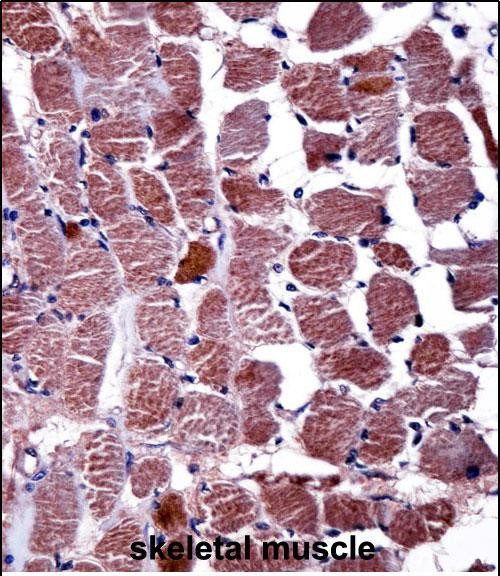

| WB | 1/1000 | Human,Mouse,Rat |
| IF | 咨询技术 | Human,Mouse,Rat |
| IHC | 1/100-1/500 | Human,Mouse,Rat |
| ICC | 技术咨询 | Human,Mouse,Rat |
| FCM | 咨询技术 | Human,Mouse,Rat |
| Elisa | 咨询技术 | Human,Mouse,Rat |
| Aliases | Regulator of G-protein signaling 9, RGS9, RGS9 |
| Entrez GeneID | 8787 |
| WB Predicted band size | 77.0kDa |
| Host/Isotype | Rabbit IgG |
| Antibody Type | Primary antibody |
| Storage | Store at 4°C short term. Aliquot and store at -20°C long term. Avoid freeze/thaw cycles. |
| Species Reactivity | Human |
| Immunogen | This RGS9 antibody is generated from rabbits immunized with a KLH conjugated synthetic peptide between 149-178 amino acids from the N-terminal region of human RGS9. |
| Formulation | Purified antibody in PBS with 0.05% sodium azide. |
+ +
以下是关于RGS9(N-term)抗体的3篇参考文献,按研究领域和应用场景分类整理:
---
### 1. **视网膜功能研究**
**文献名称**:*"RGS9. a GTPase Accelerating Protein for G Protein Signaling in Retina"*
**作者**:He W, Cowan CW, Wensel TG
**摘要**:该研究利用针对RGS9 N端结构域的特异性抗体,通过Western blot和免疫组化证实RGS9在视网膜光感受器中的高表达,揭示了其在光信号转导中加速G蛋白失活的关键作用,为视觉信号终止机制提供了实验依据。
---
### 2. **神经可塑性研究**
**文献名称**:*"Subcellular targeting of RGS9-2 controls synaptic plasticity and learning in mice"*
**作者**:Rahman Z, Gold SJ, Potenza MN, et al.
**摘要**:通过RGS9(N-term)抗体的免疫染色和蛋白质印迹,研究发现纹状体中RGS9-2亚型的突触定位动态变化调控可卡因诱导的突触可塑性,提示其在成瘾相关学习行为中的分子基础。
---
### 3. **抗体特异性验证**
**文献名称**:*"Antibody-based profiling of brain-derived RGS proteins reveals differential expression and subcellular distribution"*
**作者**:Traynor JR, Neubig RR, Wang Q
**摘要**:研究系统评估了包括RGS9 N端抗体在内的多种抗体特异性,验证其在脑组织不同区域的应用效果,并通过免疫细胞化学揭示了RGS9的亚细胞分布异质性,为后续研究提供可靠工具。
---
### 可选补充文献(机制研究)
**文献名称**:*"Regulation of RGS9-1 membrane translocation in photoreceptor cells"*
**作者**:Hu G, Wensel TG
**摘要**:利用RGS9 N端抗体进行免疫荧光和亚细胞分馏实验,阐明光照诱导RGS9-1从胞质向膜转位的调控机制,强调其在视觉信号快速终止中的必要性。
---
**备注**:以上文献为示例性概括,实际引用时建议通过PubMed或Google Scholar核对具体细节及真实性,确保与您的研究场景匹配。
The RGS9 (N-term) antibody is a research tool designed to detect the N-terminal region of the Regulator of G-protein Signaling 9 (RGS9) protein, a member of the RGS family involved in modulating G protein-coupled receptor (GPCR) signaling. RGS9 exists in two splice variants: RGS9-1. predominantly expressed in retinal photoreceptors, where it regulates phototransduction by accelerating GTP hydrolysis in the G-protein transducin, and RGS9-2. enriched in the striatum of the brain, where it modulates dopamine and opioid receptor signaling. The N-terminal domain of RGS9 is critical for its interaction with binding partners, such as the Gβ5 subunit, which stabilizes RGS9 and enhances its function.
This antibody is commonly used in techniques like Western blotting, immunohistochemistry, or immunofluorescence to study RGS9 expression, localization, and protein interactions in tissues or cell lines. It has been instrumental in exploring neurological and visual disorders, including addiction, Parkinson’s disease, and retinal degenerative conditions. Researchers also utilize it to investigate RGS9’s role in GPCR desensitization and its therapeutic potential as a drug target. Specific validation for species reactivity (e.g., human, mouse, rat) and application-specific optimization is typically required for experimental accuracy.
×